Articles
- Page Path
- HOME > J Korean Acad Nurs > Volume 42(2); 2012 > Article
-
Original Article
- Homebound status and Related Factors According to Age in Female Elders in the Community
- Kyungwon Choi, EunA Park, In-Sook Lee
-
Journal of Korean Academy of Nursing 2012;42(2):291-301.
DOI: https://doi.org/10.4040/jkan.2012.42.2.291
Published online: April 30, 2012
1Full-time lecturer, Department of Nursing, Hyechon University, Daejeon, Korea.
2Doctoral Student, College of Nursing, Seoul National University, Seoul, Korea.
3Professor, College of Nursing, Seoul National University, Seoul, Korea.
- Address reprint requests to: Park, EunA. The Building for Research of College of Nursing, 406?? 28 Yeongeon-dong, Jongro-Gu, Seoul National University, Seoul, Republic of Korea. Tel: +82-2-740-8468, 010-3999-1673, Fax: +82-2-741-1574, pea0701@hanamil.net
© 2012 Korean Society of Nursing Science
- 753 Views
- 6 Download
- 16 Crossref
Abstract
-
Purpose
- The purpose of this study was to investigate homebound status and significant related factors for community-dwelling female elders according to age.
-
Methods
- The participants were female elders over 65 years of age registered in public health centers. Data were collected by interviewing the elders, who voluntarily completed the entire survey. For data analysis, descriptive statistics and multiple logistic regression were performed using SPSS version 18.0.
-
Results
- There were statistically significant differences in homeboundness and related factors between the young-old (65 to 74 years of age) and the old-old (75 years of age or older). The level of homeboundness of the old-old was higher than that of the young-old. Multiple logistic regression showed, timed "up and go", depression, and fear of falling as significantly associated with homebound status of the young-old, while hand grip strength (right), timed "up and go", static balance ability, severity of urinary incontinence, and fear of falling as significant for the old-old.
-
Conclusion
- The findings of this study indicate that homebound status and related factors for elders are different according to age, and therefore, interventions to prevent and help homebound elders get over being homebound should be developed according to age.
- 1. Berlau D.J., Corrada M.M., Kawas C. The prevalence of disability in the oldest-old is high and continues to increase with age: Findings from the 90+Study. International Journal of Geriatric Psychiatry. 2009;24:1217–1225. http://dx.doi.org/10.1002/gps.2248.ArticlePubMedPMC
- 2. Charlson M.E., Peterson J.C., Syat B.L., Briggs W.M., Kline R., Dodd M., et al. Outcomes of community-based social service interventions in homebound elders. International Journal of Geriatric Psychiatry. 2008;23:427–432. http://dx.doi.org/10.1002/gps.1898.ArticlePubMed
- 3. Choi Y.H. A study on depression, sleep and fatigue in younger and older elders. Journal of Korean Academy of Community Health Nursing. 2007;18:223–231.
- 4. Cohen-Mansfield J, Shmotkin D, Hazan H. The effect of homebound status on older persons. Journal of the American Geriatrics Society. 2010;58:2358–2362. http://dx.doi.org/10.1111/j.1532-5415.2010.03172.x.ArticlePubMedPMC
- 5. Fujita K., Fujiwara Y., Kumagai S., Watanabe S., Yoshida Y., Motohashi Y., et al. The frequency of going outdoors, and physical, psychological and social functioning among community dwelling older adults. Japanese Journal of Public Health. 2004;51:168–180.PubMed
- 6. Haley S.M., Jette A.M., Coster W.J., Kooyoomjian J.T., Levenson S., Heeren T., et al. Late life function and disability instrument: II. Development and evaluation of the function component. The Journals of Gerontology. Series A, Biological Sciences and Medical Sicenc. s. 2002;57:M217–M222. http://dx.doi.org/10.1093/gerona/57.4.M217.
- 7. Hendrickson L.S. The frequency of stress incontinence in women before and after the implementation of an exercise program. Issues in Health Care of Women. 1981;3(2):81–92.ArticlePubMed
- 8. Imuta H., Yasumura S., Ahiko T., Fukao A. Predictors of functional status among independent and homebound community dwelling elderly: Physical, psychological, and social parameters. Japanese Journal of Public Health. 2002;49:483–496.PubMed
- 9. Inoue K., Matsumoto M. Homebound status in a community-dwelling elderly population in Japan. Asia-Pacific journal of public health. 2001;13:109–115. http://dx.doi.org/10.1177/101053950101300209.ArticlePubMedPDF
- 10. Kee B.S. A preliminary study for the standardization of geriatric depression scale short form-Korea version. Journal of Korean Neuropsychiatric Association. 1996;35:298–307.
- 11. Kono A., Kanagawa K. A qualitative study on the structure of "TOJIKOMORI" phenomenon among home disabled elderly-a daily life of house-bound elderly. Journal of Japanese Academy of Nursing Science. 1999;19:23–30.
- 12. Kono A., Kanagawa K. Characteristics of housebound elderly by mobility level in Japan. Nursing and Health Sciences. 2001;3:105–111.ArticlePubMed
- 13. Kono A., Kai I., Sakato C., Rubenstein L.Z. Frequency of going outdoors: A predictor of functional and psychosocial change among ambulatory frail elders living at home. The Journals of Gerontology. Series A, Biological Sciences and Medical Sciences. 2004;59:275–280.PubMed
- 14. Lee K.J., Kim H.S. A study on the perceived health status, depression, and activities of daily living for the elderly in urban areas. Korean Journal of Women Health Nursing. 2006;12:221–230.ArticlePDF
- 15. Lee M.S. Sense of mastery and depression in community dwelling elders. 2000;Iksan, Wonkwang University. Unpublished master's thesis.
- 16. Lee Y.S. The effect of pelvic floor muscle exercise on female urinary incontinence. 1993;Seoul, Yonsei University. Unpublished Doctoral Dissertation.
- 17. Li F., Fisher K.J., Harmer P., McAuley E., Wilson N.L. Fear of falling in elderly persons: Association with falls, functional ability, and quality of life. The Journals of Gerontology. Series B, Psychological Sciences and Social Sciences. 2003;58:283–290. http://dx.doi.org/10.1093/geronb/58.5.P283.
- 18. Matos L.C., Tavares M.M., Amaral T.F. Handgrip strength as a hospital admission nutritional risk screening method. European Journal of Clinical Nutrition. 2007;61:1128–1135. http://dx.doi.org/10.1038/sj.ejcn.1602627.ArticlePubMedPDF
- 19. Ministry of Health and Welfare Affairs. Manual for a customized home visiting health service. 2009;Seoul, Author.
- 20. Payette H., Boutier V., Coulombe C., Gray-Donald K. Benefits of nutritional supplementation in free-living, frail, undernourished elderly people: A prospective randomized community trial. Journal of the American Dietetic Association. 2002;102:1088–1095. http://dx.doi.org/10.1016/S0002-8223(02)90245-2.ArticlePubMed
- 21. Peduzzi P., Concato J., Kemper E., Holford T.R., Feinstein A.R. A simulation study of the number of events per variable in logistic regression analysis. Journal of Clinical Epidemiology. 1996;49:1373–1379. http://dx.doi.org/10.1016/S0895-4356(96)00236-3.ArticlePubMed
- 22. Podsiadlo D., Richardson S. The timed "Up & Go': A test of basic functional mobility for frail elderly persons. Journal of the American Geriatrics Society. 1991;39:142. ArticlePubMed
- 23. Shinaki S. Homeboundness in the elderly. Japanese Journal of Geriatrics. 2008;45:117–125.PubMed
- 24. Shinaki S., Fujita K., Fujiwara Y., Kumagai S., Amano H., Yoshida H., et al. Prevalence and characteristics of different types of homeboundness among community-living older adults. Japanese Journal of Public Health. 2005a;52:443–455.PubMed
- 25. Shinkai S, Fujita K, Fujiwara Y, Kumagai S, Amano H, Yoshida Y, et al. Prognosis of different types of homeboundness among community-living older adults: Two-year prospective study. Japanese Journal of Public Health. 2005b;52:627–638.PubMed
- 26. Steffen TM, Hacker TA, Mollinger L. Age- and gender-related test performance in community-dwelling elderly people: Six-minute walk test, berg balance scale, timed up & go test, and gait speeds. Physical Therapy. 2002;82:128–137. http://ptjournal.apta.org/content/82/2/128.ArticlePubMedPDF
- 27. Vellas B.J., Wayne S.J., Romero L., Baumgartner R.N., Rubenstein L.Z., Garry P.J. One-leg balance is an important predictor of injurious falls in older persons. Journal of the American Geriatrics Society. 1997;45:735–738.ArticlePubMed
- 28. World Health Organization. Strategy for integrating gender analysis and actions into the work of WHO. 2007;03;Geneva, Author.
- 29. Yesavage J.A., Brink T.L., Rose T.L., Lum O., Huang V., Adey M., et al. Development and validation of a geriatric depression screening scale: A preliminary report. Journal of Psychiatric Research. 1982-1983;17(1):37–49.Article
- 30. Zimmerman R.K., Middleton D.B. Vaccines for persons at high risk due to medical conditions, occupation, environment, or lifestyle. Journal of Family Practice. 2005;54:S27–S36.PubMed
REFERENCES
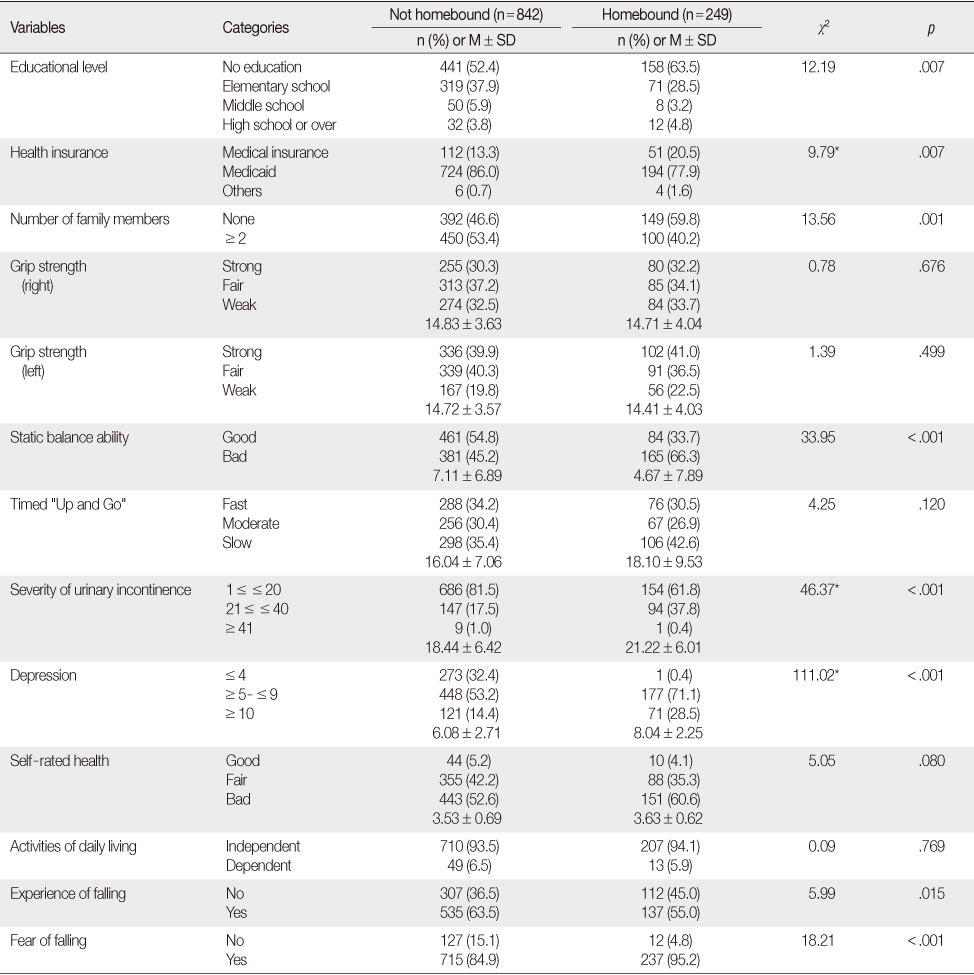
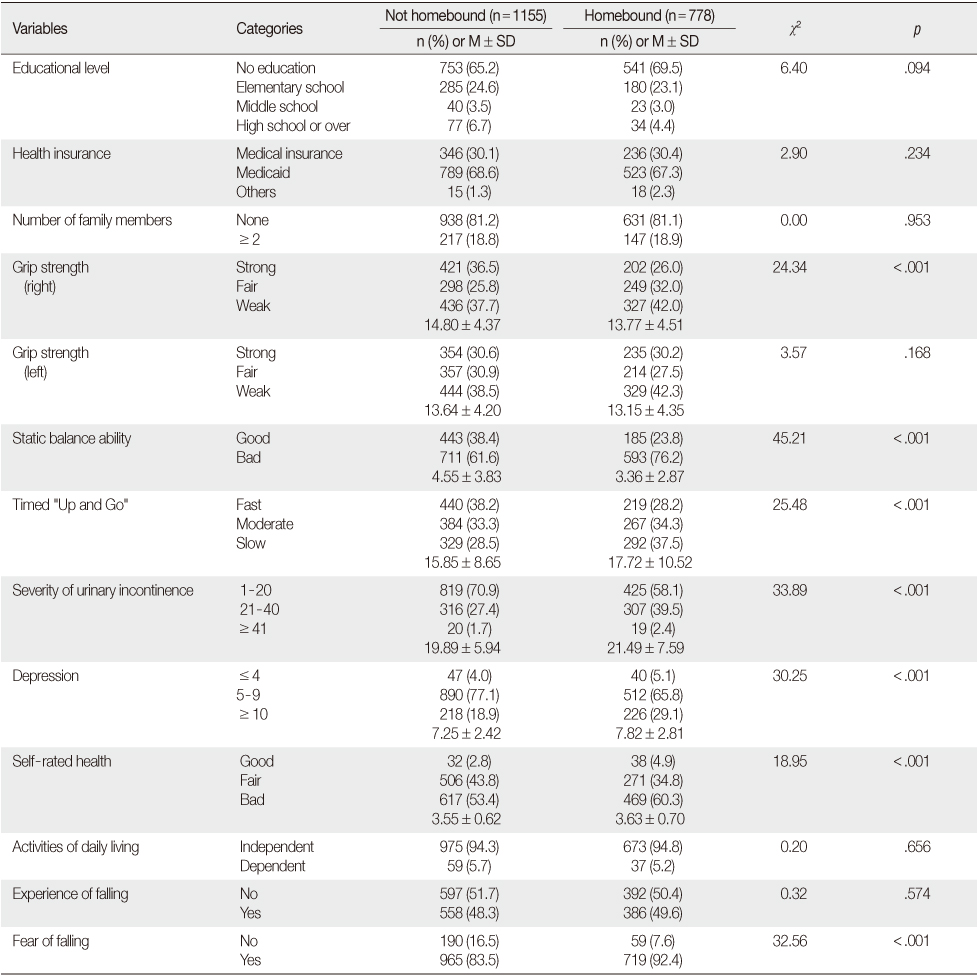
Figure & Data
REFERENCES
Citations

- Multidimensional factors affecting homebound older adults: A systematic review
JuHee Lee, Yujin Suh, Yielin Kim
Journal of Nursing Scholarship.2022; 54(2): 169. CrossRef - Effects of Social Interaction and Depression on Homeboundness in Community-Dwelling Older Adults Living Alone
You-Ri Kim, Hye-Sun Jung
International Journal of Environmental Research and Public Health.2022; 19(6): 3608. CrossRef - Mental Health and Handgrip Strength Among Older Adults: A Nationwide Study
Yeunhee Kwak, Yoonjung Kim
INQUIRY: The Journal of Health Care Organization, Provision, and Financing.2022;[Epub] CrossRef - A Scoping Review of Homebound Older People: Definition, Measurement and Determinants
Young Ko, Wonjung Noh
International Journal of Environmental Research and Public Health.2021; 18(8): 3949. CrossRef - Sex-Based Differences in the Association between Nutrition Label Awareness and the Prevalence of Atopic Dermatitis: A Cross-Sectional Survey
Soo Jin Kwon, Yoonjung Kim
Healthcare.2020; 8(3): 210. CrossRef - Factors associated with going outdoors frequently: a cross-sectional study among Swiss community-dwelling older adults
Julia Spaltenstein, Christophe Bula, Brigitte Santos-Eggimann, Helene Krief, Laurence Seematter-Bagnoud
BMJ Open.2020; 10(8): e034248. CrossRef - Quality of life and subjective health status according to handgrip strength in the elderly: a cross-sectional study
Yeunhee Kwak, Yoonjung Kim
Aging & Mental Health.2019; 23(1): 107. CrossRef - Home-Based Primary Care for Homebound Older Adults: Literature Review
Chang-O Kim, Soong-Nang Jang
Annals of Geriatric Medicine and Research.2018; 22(2): 62. CrossRef - Urinary incontinence in women in relation to occupational status
Yoonjung Kim, Yeunhee Kwak
Women & Health.2017; 57(1): 1. CrossRef - Homebound status among middle-aged and older adults with disabilities in ADLs and its associations with clinical, functional, and environmental factors
Iván De-Rosende Celeiro, Sergio Santos-del-Riego, Javier Muñiz García
Disability and Health Journal.2017; 10(1): 145. CrossRef - Occurrence of and factors influencing elderly homebound in Chinese urban community
Li-Wei Jing, Feng-Lan Wang, Xiao-Li Zhang, Ting Yao, Feng-Mei Xing
Medicine.2017; 96(26): e7207. CrossRef - Factors Affecting the Intention to Participate in Healthcare Programs among Elders Living Alone
Mi Sook Song, Sunjoo Boo
Journal of Korean Academy of Community Health Nursing.2016; 27(4): 319. CrossRef - The Effect of an Exercise Program for Preventing Urinary Incontinence among Community-Dwelling Elderly Females Living Alone
Mi Sook Song, Sunjoo Boo
Journal of Korean Public Health Nursing.2016; 30(2): 247. CrossRef - The Relationship Between Hand Grip Strength and Cognitive Function in Older Adults: The Moderating Effect of Regular Exercise
Sungeun Lee
The Korean Journal of Community Living Science.2014; 25(1): 29. CrossRef - Prevalence of Urinary Incontinence, Single Voided Volume, Post Void Residual Volume, Daytime Frequency, and Nocturia in Women over 40 Years
Ok Boon Kim, Haesang Yoon
Korean Journal of Adult Nursing.2013; 25(6): 679. CrossRef - Prevalence of Urinary Incontinence, Single Voided Volume, Post Void Residual Volume, Daytime Frequency, and Nocturia in Women over 40 Years
Ok Boon Kim, Haesang Yoon
Korean Journal of Adult Nursing.2013; 25(6): 679. CrossRef
Participant Characteristics according to Age Difference (N=3,024)
*Young-old: 65-74 years old of age; †Old-old: 75 years old of age or over.
Comparison of Characteristics according to Homebound Status for Young-old Participants (N=1091)
*Fisher's exact test.
Comparison of Characteristics according to Homebound Status for Old-old Participants (N=1933)
Predictors of Homebound Status of Young-old Participants by Multiple Logistic Regression Analysis (N=1091)
*Adjusted variables: Education level, health insurance, number of family members.
Predictors of Homebound Status of Old-old Participants by Multiple Logistic Regression Analysis (N=1933)
*Adjusted variables: Education level, health insurance, number of family members.
*Young-old: 65-74 years old of age; †Old-old: 75 years old of age or over.
*Fisher's exact test.
*Adjusted variables: Education level, health insurance, number of family members.
*Adjusted variables: Education level, health insurance, number of family members.
 KSNS
KSNS
 E-SUBMISSION
E-SUBMISSION
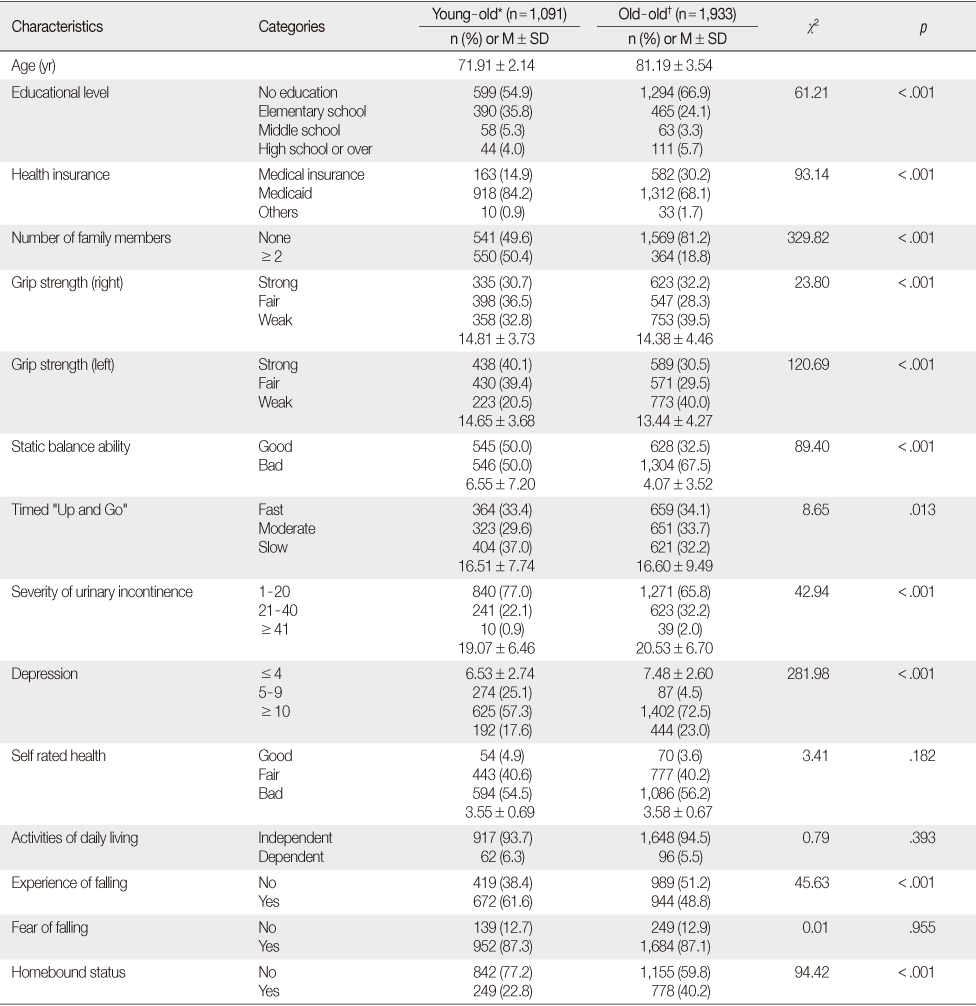
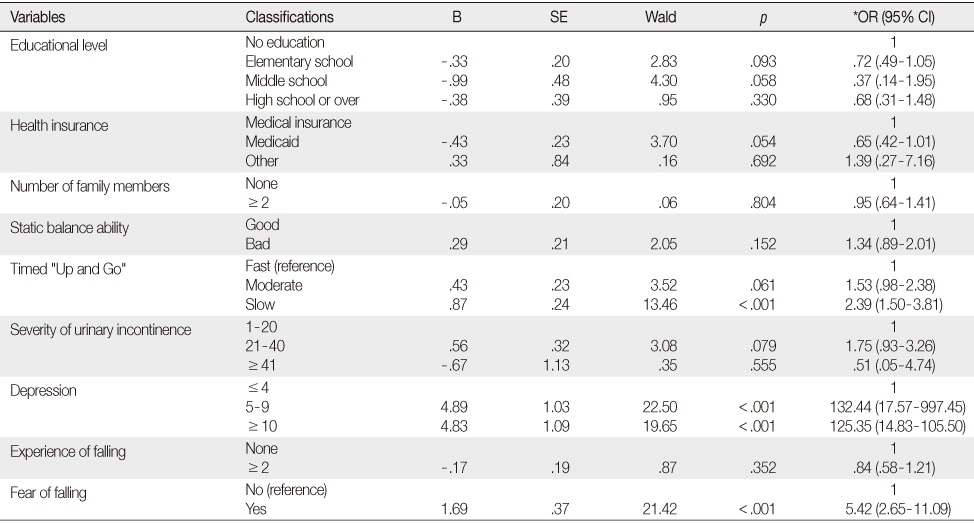
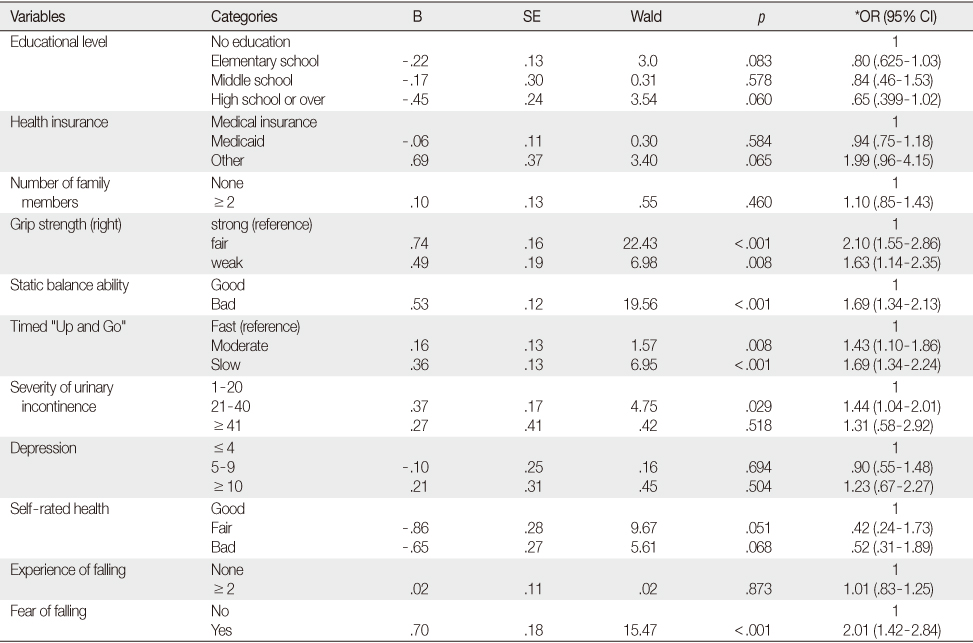
 Cite
Cite

